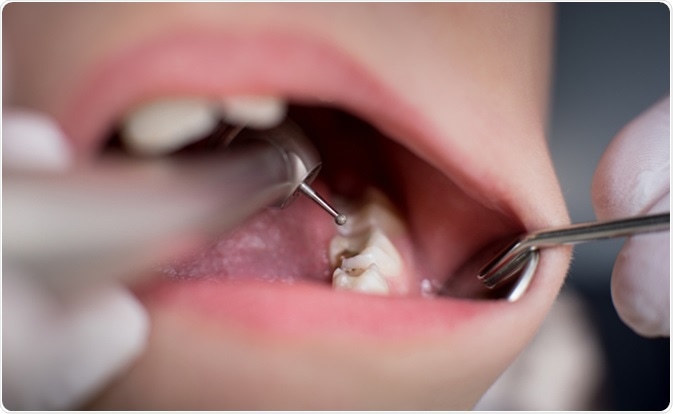By H H Patel, M.Pharm.
Dentistry is the branch of medical science dealing with the investigation, treatment, and prophylaxis of the ailments of teeth and oral cavity. Dental problems have increased in frequency as one of the effects of the modern lifestyle. This may be traced to several reasons including the higher intake of junk food, soft drinks and neglecting to take care of one’s teeth. Hence, dental visits have become the norm nowadays.
Dental science has evolved a lot over the last few decades just as other areas of medical science. Dental surgery have been modernized as well as digitalized. However, for a majority of dental ailments, dentists still rely on medications, either alone or as part of preoperative management. In order to treat dental problems with medications, an adequate knowledge of the underlying pharmacology is a must.
Pharmacology is an applied science dealing with drug action on the body, and the metabolism of drugs by the body.

Image Credit: Anatoliy_gleb / Shutterstock
Pharmacokinetics and Pharmacodynamics of Dental Drugs
Pharmacology plays an important role in dentistry. The aim of dental pharmacology is to understand the scientific aspects of how drugs used in dentistry act within various body systems.
Pharmacology encompasses two aspects of drug metabolism – pharmacokinetics and pharmacodynamics. While pharmacokinetics deals with drug absorption, distribution, metabolism, and excretion, pharmacodynamics deals with drug efficacy, safety, receptor occupancy (potency), and drug interactions. Knowledge of all these aspects with respect to a given drug is necessary in order to successfully treat a dental condition using the drug.
Pharmacokinetics
Following the oral or topical administration of a drug, its absorption requires that it be lipid soluble, as it can then diffuse through the epithelium and reach the capillaries.
Drug molecules travel in the bloodstream either in the free or unbound state, or bound to plasma proteins. Only the unbound drug is free and is distributed to the tissues. Further, the parent drug may be converted to a number of metabolites.
Either the parent drugs or their metabolites may be active/inactive and toxic/non-toxic. After metabolism, the course of elimination of the drug also varies depending on the route of administration and the physicochemical properties of the drug.
Pharmacodynamics
Drug action depends on the state of the receptors (active or inactive). Drugs interact with receptors in a variety of ways. Antagonists bind to receptors and do not activate either receptor state. Agonists bind as well as activate the receptors. Inverse agonists selectively stimulate the inactive receptor state by initiating the cellular response opposite to that generated by a natural agonist.
The efficacy and potency of drugs used in dentistry is determined by how well the drug binds with the receptors and triggers the desired response. The potency of these drugs is determined as the amount of drug required to produce a chosen intensity of effect. The drug doses are calculated for a given formulation (spray, gargle, rinse, tablet, ointment, or patch etc.) on the basis of all these factors. Additionally, it is equally important to understand the toxic effects associated with dental medicines, and any interactions with other drugs.
Medications Used in Dentistry
Several classes of drugs are utilized in dentistry depending on the requirement.
For instance, local anesthetics, general anesthetics, or nitrous oxide are administered to reduce the perception of pain associated with several dental conditions and procedures, and accompanying anxiety. Anesthetic medications bind to the sodium channels, blocking the conduction of nerve stimuli, and hence they are useful during procedures such as tooth extraction.
Local anesthetic ointments are also prescribed for application before meals, in order to numb the area of pain, so that the patient can eat peacefully. The onset and duration of action of these medications depend upon factors such as proximity to target site, concentration (dose), pH of the tissue, lipid/aqueous solubility, protein binding, and tissue redistribution of the drug. Their side effects may range from mild confusion and talkativeness to tonic-clonic seizures and severe depression. Nerve injury is also one of the serious but less common adverse effects of dental anesthetics.
Anti-inflammatory and analgesic medications including corticosteroids are also used to relieve the pain. These are the most common categories of drugs used in dentistry, and are available in different dosage forms. Analgesics such as non-steroidal anti-inflammatory drugs (NSAIDs) attach themselves to cyclooxygenase (COX) receptors – COX1 or COX2, and inhibit these enzymes. They possess antipyretic and anti-inflammatory activities in addition to analgesic activities. COX2 inhibitors are particularly beneficial as they produce fewer or no gastrointestinal adverse effects compared with COX1 inhibitors. Other side effects of NSAIDs include renotoxicity, dyspepsia, and anaphylactic reactions. Opioids are another category of drugs used in dentistry as analgesics and sedatives. They directly affect the central nervous system. Addiction and withdrawal symptoms are potential problems associated with the long-term usage of opioids.
Another important category is antibiotics and antiseptics which are employed to treat the ailments such as plaque and gingivitis, and anti-fungal medicines which are used to treat oral thrush. These medicines target the gums and the dental roots, and are available as oral pills, mouth rinses and gargles. They are also utilized to treat breath odor. Bacteriostatic as well as bactericidal antibiotics include penicillins, cephalosporins, tetracyclines, aminoglycosides etc. classes of drugs. The choice of antibiotics is driven by several factors including type of infection, age of the patient, compliance, medical history, concomitant medications, and bacterial resistance.
Also, fluoride containing products are used to prevent tooth decay on a non-prescription basis in areas without fluoridation of water.
Further Reading
Last Updated: Oct 10, 2022